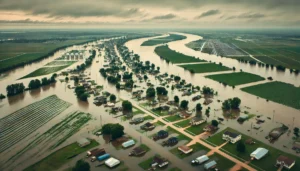The Great Flood of 1993 stands as one of the most catastrophic floods in United States history, impacting the Midwestern region, particularly the Mississippi and Missouri river basins. Lasting from April to October 1993, this flood caused unprecedented destruction across several states, leading to extensive economic, social, and environmental repercussions.
Causes of the Flood
Excessive Rainfall
The flood was triggered by a series of weather events that began in the spring of 1993. The region experienced above-average rainfall, with some areas receiving up to 48 inches of rain—nearly double their typical amount for the season. This heavy rainfall was exacerbated by a persistent weather pattern that stalled over the Midwest, allowing storms to linger and dump excessive amounts of water.
Saturated Soil and Snowmelt
By the time the heavy rains commenced, the soil was already saturated from previous precipitation. This saturation meant that the ground had little capacity for further absorption, leading to rapid runoff into rivers. Additionally, a significant snowpack from the preceding winter contributed to the rising water levels, particularly as temperatures warmed and snow began to melt.
The Impact and Damage
Economic Losses
The Great Flood of 1993 inflicted approximately $15 billion in damages. The destruction of farmland, homes, and critical infrastructure led to long-term economic challenges for the affected regions. Agricultural losses were particularly severe, with many farmers facing years of recovery.
Displacement and Casualties
Over 50,000 homes were destroyed, displacing around 54,000 people. Communities were uprooted as families were forced to evacuate their homes, many of which were rendered uninhabitable. Tragically, the flood resulted in 50 deaths, highlighting the human cost of this natural disaster.
Levee Failures
One of the most significant contributors to the flood’s severity was the failure of levees. More than 1,000 levees, both federal and private, were either overtopped or failed completely, allowing rivers to inundate vast areas of land. This widespread levee failure led to rapid and extensive flooding in many communities.
Affected Areas
The Mississippi River
The Mississippi River was one of the hardest-hit areas, swelling far beyond its banks and flooding large sections of Missouri, Illinois, and Iowa. In St. Louis, the river reached a record crest of 49.58 feet on August 1, 1993. This unprecedented rise caused extensive damage to homes, businesses, and infrastructure along the river.
The Missouri River
Flooding was particularly severe along the Missouri River and its tributaries. Cities like Jefferson City and Kansas City, Missouri, experienced significant inundation, further exacerbating the crisis.
Response and Recovery
In the face of this monumental disaster, a massive response effort was initiated. Local authorities, the National Guard, and federal agencies such as FEMA mobilized resources to assist affected communities. Volunteers played a crucial role in sandbagging efforts and reinforcing levees, showcasing the spirit of solidarity in times of crisis.
In the aftermath of the flood, discussions arose regarding better flood management and prevention strategies. Policymakers emphasized the need to revise levee systems, restore wetlands, and consider relocating homes and businesses away from flood-prone areas.

The Great Flood of 1993 had a lasting impact on floodplain management policies and infrastructure improvements in the Midwest. It underscored the vulnerability of human settlements along major rivers in the United States to natural disasters of such magnitude. The lessons learned from this event continue to shape flood management strategies and disaster preparedness efforts today.
